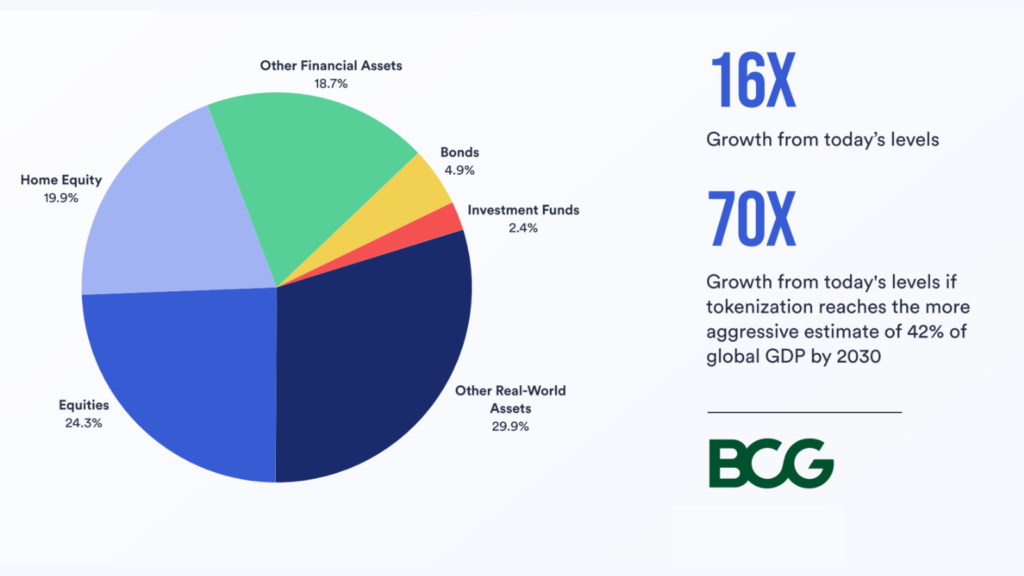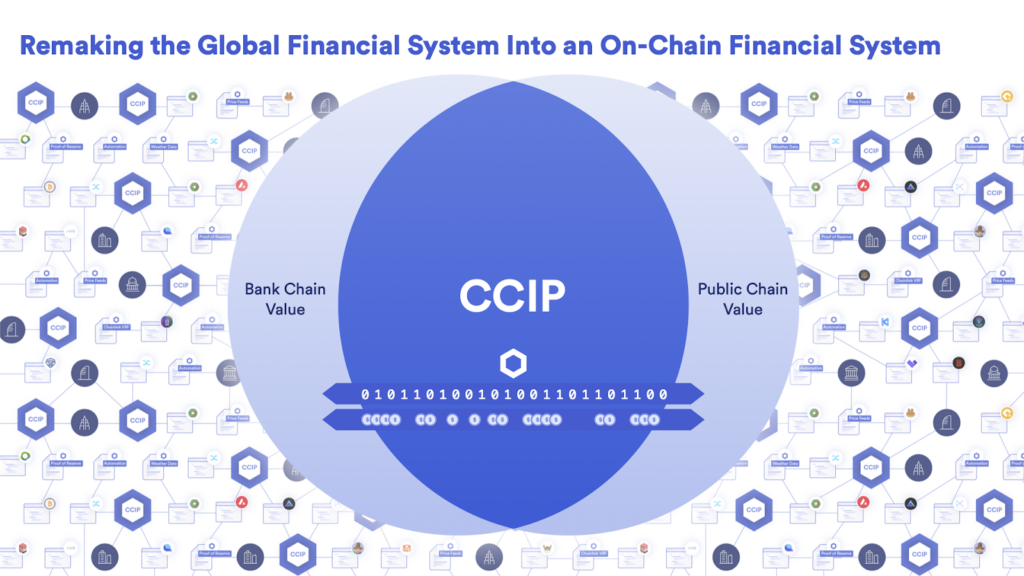From TCP/IP to CCIP: Chainlink and the New Internet of Contracts
The future is on. The replatforming of capital markets into on-chain finance is projected to disrupt more than $867 trillion in global asset value.
Powering this transformation is the Chainlink Cross-Chain Interoperability Protocol (CCIP), a breakthrough in blockchain connectivity and interoperability that enables DeFi applications to access users and interface with other DeFi applications across different blockchains, all from a single interface. CCIP also gives existing financial systems a seamless connection to public and private blockchains—making it easy for them to transition existing assets and financial services on-chain. If successful, we could see trillions of dollars in new assets flow into blockchain ecosystems.
Catalyzing the Next DeFi Revolution
Over the past few years, the cross-chain ecosystem has experienced growing pains, as previous cross-chain solutions have suffered a number of exploits due to poor design choices, large attack surfaces, and complex user experiences. Over $2.6B has been exploited due to cross-chain bridge hacks thus far. What the market needs is a cross-chain solution with a higher standard of security, reliability, and usability.
64% of funds stolen in DeFi hacks in 2022 were from cross-chain bridge hacks, according to Chainalysis.
1/ The Chainlink Cross-Chain Interoperability Protocol (CCIP) has officially launched on Avalanche, Ethereum, Optimism, and Polygon mainnets.#LinkTheWorld pic.twitter.com/SdLVyaapg3
— Chainlink (@chainlink) July 17, 2023
Pioneered by a world-class research team, CCIP raises the bar in cross-chain security by introducing new features, such as rate limits on token transfers as a way to minimize potential damage and the Risk Management Network—an independent network that verifies cross-chain operations for erroneous activity. CCIP also establishes new standards in cross-chain reliability and usability by introducing features such as Smart Execution—a gas-locked fee payment mechanism where users only need to pay on the source chain and CCIP will take care of execution on the destination chain.
Underpinning these new features is the same Chainlink foundation of decentralized oracle networks that have already helped secure tens of billions of dollars for DeFi protocols and enabled over $12 trillion in on-chain transaction value.
CCIP is now running live on Mainnet for Early Access participants, which include two leading DeFi protocols:
- Synthetix—CCIP enables synth tokens to flow seamlessly across chains to wherever there is the greatest immediate demand, deepening liquidity and increasing capital efficiency.
- Aave—CCIP is being integrated to power Aave’s multi-chain governance system, saving significant time and developer resources and increasing protocol security.
“Security is critical when dealing with on-chain assets, which is why we leverage Chainlink CCIP for our cross-chain Synths Teleporter.”—Kain Warwick, Founder, Synthetix
The On-Chain Gateway for the World’s Biggest Banks

Hundreds of trillions of dollars flow across global financial markets. Universal and frictionless connectivity across financial markets is a massive value-add for all participants, which is why widely adopted financial market infrastructure providers such as DTCC, Euroclear, and Swift exist.
While 97% of institutional investors agree that “tokenization will revolutionize asset management,” there have been two long-standing roadblocks to moving hundreds of trillions of dollars worth of assets on-chain:
- Blockchain connectivity (legacy-to-blockchain): The ability to connect the core business infrastructure of existing financial systems to any blockchain.
- Cross-chain interoperability (blockchain-to-blockchain): A highly secure communication standard that can connect any public or private chain to one another.
CCIP overcomes these challenges. In a recently announced collaboration with Swift, Chainlink CCIP is helping enable end-to-end communication between legacy systems and blockchain networks, as well as interoperability across both public and private blockchains. Over a dozen major global financial institutions and financial market infrastructure providers are participating in the collaboration, including DTCC, BNY Mellon, Citi, and Euroclear.
“[This collaboration] will also highlight the potential value of using a blockchain interoperability protocol to securely transfer data and value between legacy systems and a potentially unlimited number of blockchains.”—Jonathan Ehrenfeld, Head of Securities Strategy at Swift
Creating the Unified Internet of Contracts

Today, the world’s contractual value is fragmented across both the existing financial system and the multi-chain Web3 ecosystem. The fragmentation of blockchain networks is similar to the early days of the Internet, where there were separate intranets, LANs, and consortiums of terminals that couldn’t interact with one another.
The early interoperability standards completely transformed the Internet. TCP/IP, HTTP, and email protocols enabled seamless connectivity between users, who then saw their web applications increase in value exponentially as more people joined the network.
It shouldn’t matter what blockchain you launch a dApp or token on or what type of backend system you want to interact from—as long as that environment is connected to an interoperability standard, it can access any chain and its supported dApps.
Now, CCIP provides a connectivity standard that enables traditional finance to easily interact with smart contracts, as well as securely transact across different public and private blockchains. Connectivity both to and across multiple blockchains is critical for creating a unified financial system where tokens and messages can seamlessly flow across different environments.
Similar to TCP/IP’s foundational role in Internet communication, Chainlink CCIP is the foundation for an interoperable blockchain ecosystem. The key difference between TCP/IP and CCIP is that while TCP/IP enables information to flow freely across the Internet, CCIP enables value to be transferred across networks securely. The launch of CCIP marks a key moment in the evolution of the Internet and moves society one step closer to a world underpinned by interoperable smart contracts: The Internet of Contracts.
“Just like key standards such as TCP/IP remade a fragmented early internet into the single global internet we all know and use today, we are making CCIP to connect the fragmented public blockchain landscape and the growing bank chain ecosystem into a single Internet of Contracts.”—Chainlink Co-Founder, Sergey Nazarov
Bringing It All Together: The On-Chain Economy Powered by Chainlink

Becoming the industry standard across both bank chains and public blockchains positions CCIP to become the universal connectivity layer bridging the gap between Web2 and Web3. We envision a future where Web3 and the global financial system are largely one and the same, with vast amounts of value flowing across these systems and chains via CCIP.
By connecting these two worlds, the extensive liquidity and technological infrastructure already present in the global financial system can take advantage of the transparency, efficiency, and connectivity advantages now available through blockchains. Given the massive size of the global banking system, if even a small fraction of assets move on-chain and connect to the Internet of Contracts, the Web3 ecosystem could grow exponentially.
If you are interested in using Chainlink as a gateway to on-chain finance, reach out to our experts.
